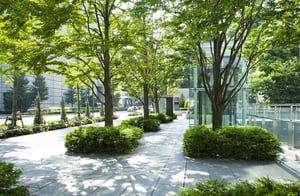In the bustling urban landscape, the significance of trees often goes unnoticed – overshadowed by busy streets, towering structures, and complex infrastructure. However, trees play a vital role in shaping the well-being and sustainability of communities.
So, what is the impact of these leafy, green guardians? And what can we do to protect them? This article dives into the transformative power of trees in creating aesthetically pleasing, eco-friendly, and healthier communities, along with tips to help them reach full maturity and long-term sustainability. We also explore how trees contribute to climate resiliency, as they can help reduce greenhouse gas emissions, moderate temperature extremes, capture carbon, filter air pollutants, and prevent soil degradation.
Whether a new development or improvements to existing infrastructure, this article captures best practices to put you on the right path.
Benefits of Trees in Urban Environments
Trees not only contribute to the beauty of city streets and public spaces, but also offer a host of practical benefits:
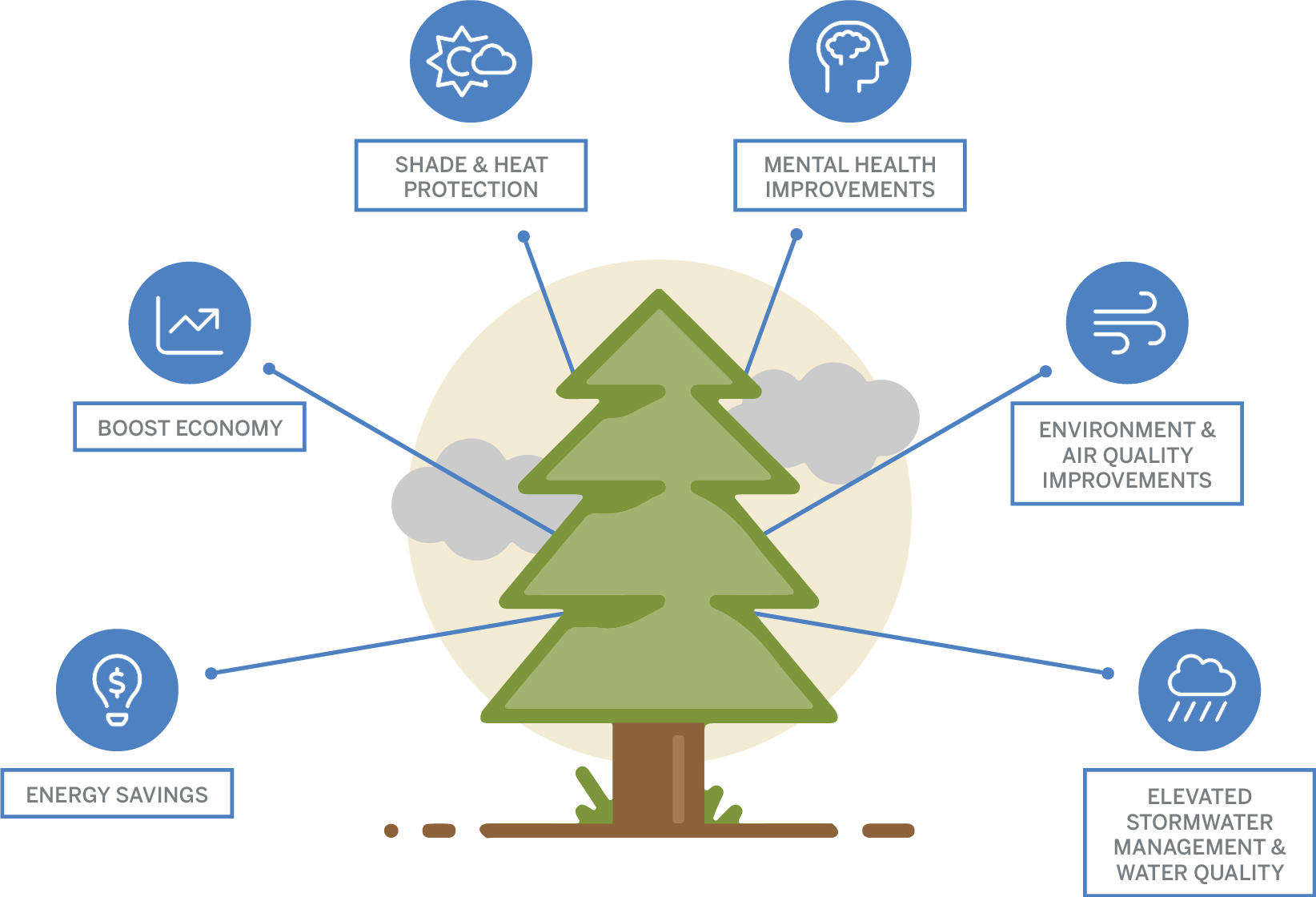
 Potential energy savings: According to the U.S. Forest Service, trees properly placed around buildings can reduce air conditioning needs by 30% and save 20-50% in energy used for heating. They also help with cooling. A young, healthy tree is equivalent to 10 room-size air conditioners operating 20 hours a day. By saving energy, trees also reduce the demand for fossil fuels and lower the carbon footprint of urban areas.
Potential energy savings: According to the U.S. Forest Service, trees properly placed around buildings can reduce air conditioning needs by 30% and save 20-50% in energy used for heating. They also help with cooling. A young, healthy tree is equivalent to 10 room-size air conditioners operating 20 hours a day. By saving energy, trees also reduce the demand for fossil fuels and lower the carbon footprint of urban areas.
 Boost to economy: The aesthetic value of trees is impressive. Trees planted in commercial areas attract businesses and tourists, meaning people are more likely to linger and shop longer on tree-lined streets – adding to the economy. Trees also increase the property value of homes and buildings, generating more tax revenue for the city.
Boost to economy: The aesthetic value of trees is impressive. Trees planted in commercial areas attract businesses and tourists, meaning people are more likely to linger and shop longer on tree-lined streets – adding to the economy. Trees also increase the property value of homes and buildings, generating more tax revenue for the city.
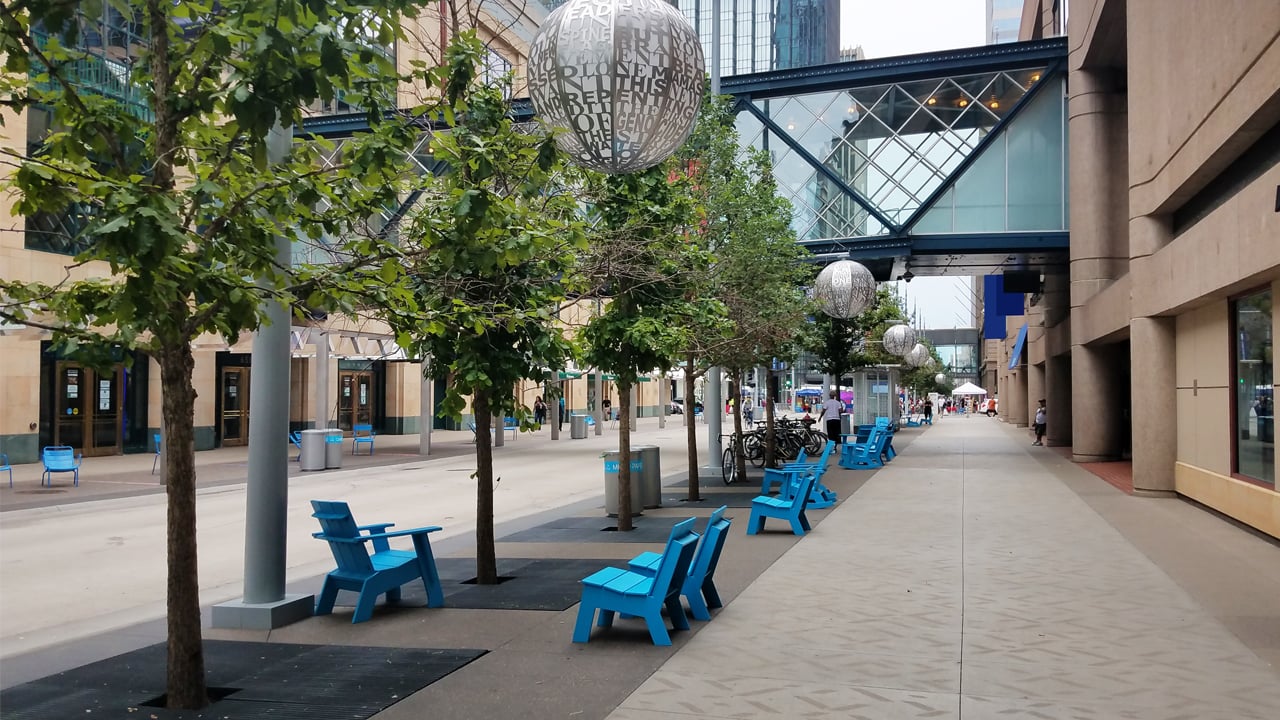
 Provides shade and heat protection: An urban area with good tree coverage can experience temperature differences of five to 15 degrees. Trees provide much-needed shade, protecting pedestrians from extreme heat and reducing sun exposure. This natural cooling effect also slows down the deterioration of building materials and street pavements, resulting in reduced maintenance costs.
Provides shade and heat protection: An urban area with good tree coverage can experience temperature differences of five to 15 degrees. Trees provide much-needed shade, protecting pedestrians from extreme heat and reducing sun exposure. This natural cooling effect also slows down the deterioration of building materials and street pavements, resulting in reduced maintenance costs.
 Improves mental health: Research indicates that an increased presence of trees and plants within our communities correlates with a decrease in negative thoughts, reduced symptoms of depression, improved moods, and heightened life satisfaction. A report by The Morton Arboretum shares that residents of tree-filled communities have fewer cardiovascular ailments. Trees also promote social cohesion and civic engagement, creating spaces for people to interact, relax, and enjoy nature. Furthermore, trees can reduce noise pollution by acting as natural sound barriers, creating a more peaceful and pleasant environment. Overall, trees make us happier people!
Improves mental health: Research indicates that an increased presence of trees and plants within our communities correlates with a decrease in negative thoughts, reduced symptoms of depression, improved moods, and heightened life satisfaction. A report by The Morton Arboretum shares that residents of tree-filled communities have fewer cardiovascular ailments. Trees also promote social cohesion and civic engagement, creating spaces for people to interact, relax, and enjoy nature. Furthermore, trees can reduce noise pollution by acting as natural sound barriers, creating a more peaceful and pleasant environment. Overall, trees make us happier people!
 Improves environment and air quality: According to the EPA, trees and vegetation act as invaluable natural buffers, playing a crucial role in improving air quality, lowering greenhouse gas emissions, and enriching the environment while enhancing public health. By increasing tree coverage in congested urban areas, we significantly reduce the impact of harmful pollutants like volatile organic compounds, carbon monoxide, particulate matter, and nitrogen oxides. Additionally, trees serve as natural air purifiers, filtering out pollutants and storing carbon dioxide, thus making a significant contribution to the fight against climate change.
Improves environment and air quality: According to the EPA, trees and vegetation act as invaluable natural buffers, playing a crucial role in improving air quality, lowering greenhouse gas emissions, and enriching the environment while enhancing public health. By increasing tree coverage in congested urban areas, we significantly reduce the impact of harmful pollutants like volatile organic compounds, carbon monoxide, particulate matter, and nitrogen oxides. Additionally, trees serve as natural air purifiers, filtering out pollutants and storing carbon dioxide, thus making a significant contribution to the fight against climate change.
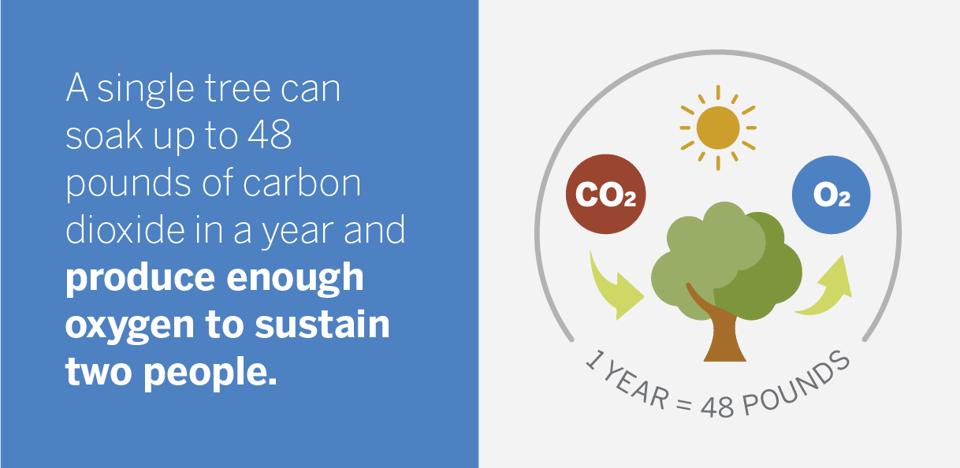
 Elevates stormwater management and water quality: Vegetation, including trees, plays an important role in managing stormwater runoff and improving water quality. By absorbing and filtering stormwater, trees help reduce runoff, mitigating the risk of urban flooding and pollution. Their presence aids in replenishing groundwater and preserving the health of urban water bodies. Trees also provide habitat and food for wildlife, supporting biodiversity and ecosystem services.
Elevates stormwater management and water quality: Vegetation, including trees, plays an important role in managing stormwater runoff and improving water quality. By absorbing and filtering stormwater, trees help reduce runoff, mitigating the risk of urban flooding and pollution. Their presence aids in replenishing groundwater and preserving the health of urban water bodies. Trees also provide habitat and food for wildlife, supporting biodiversity and ecosystem services.
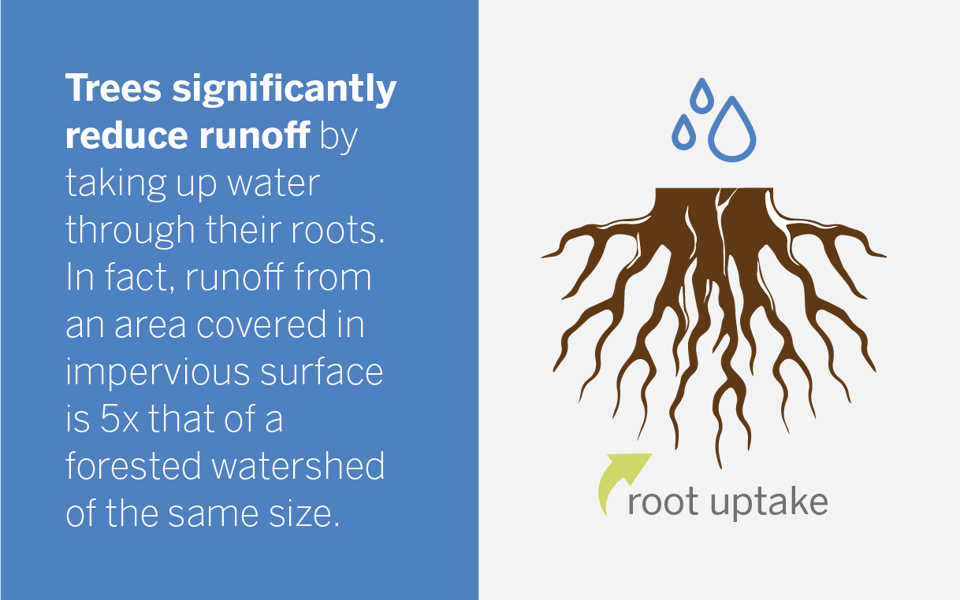
5 Best Practices for Planting in Urban Environments
While incorporating trees into the urban landscape is essential, ensuring their protection and longevity is equally as important. Many urban trees only make it to a fraction of their potential life cycle due to issues like pests and disease or, more often, stress caused by improper care and installation. A recent USDA paper analyzing tree life expectancy in urban areas found the typical street tree lived between 19 and 28 years. To compare, the ideal life span of a white oak is potentially 300 years, and the average life span of a red maple can be up to 150 years.
To maximize the benefits of urban trees and extend their life span, it’s important to adopt best practices. According to landscape architect Karl Weissenborn, the first step is to make sure you put the right tree in the right location – paying attention to the existing context, conditions, and environment.
“This can be deceptive; you need to evaluate all site and environmental factors along with cost and maintenance. No matter if you are dealing with existing infrastructure or breaking ground on a previously undeveloped area, investing early in the process and putting in the extra effort will pay off in the long run,” shares Weissenborn.
With experience working within environmental constraints, engineer Jeremy Tomesh collaborated with Weissenborn to offer five recommended best practices to help incorporate trees into the urban environment.
 Choose the right tree for the right location. Carefully select tree species that are well-suited to the urban environment, considering factors such as space, sunlight exposure, and soil conditions. A technical manual published by the U.S. Forest Service provides guidance on which trees are best to plant in specific areas. For example, some trees are more tolerant of salt, deicing chemicals, drought or prolonged water inundation, or pollution than others, and some have root systems that can damage sidewalks, pipes, foundations, or buried utilities.
Choose the right tree for the right location. Carefully select tree species that are well-suited to the urban environment, considering factors such as space, sunlight exposure, and soil conditions. A technical manual published by the U.S. Forest Service provides guidance on which trees are best to plant in specific areas. For example, some trees are more tolerant of salt, deicing chemicals, drought or prolonged water inundation, or pollution than others, and some have root systems that can damage sidewalks, pipes, foundations, or buried utilities.Related Content: La Crosse's King Street Greenway
 Space trees properly for their mature size. Plan ahead for expected tree maturity. As noted in a report by the USDA, “In the cramped environments of U.S. cities, every inch counts, especially if attempting to make space for nature.” Knowing the tree’s maximum size and genetic characteristics will help avoid future conflicts between roots and sidewalks, nearby vegetation, or power lines. A general rule of thumb is to allow at least 10 ft. of clearance between the tree and any overhead or underground utility lines, and at least 4 ft. of clearance between the tree and any pavement or building.
Space trees properly for their mature size. Plan ahead for expected tree maturity. As noted in a report by the USDA, “In the cramped environments of U.S. cities, every inch counts, especially if attempting to make space for nature.” Knowing the tree’s maximum size and genetic characteristics will help avoid future conflicts between roots and sidewalks, nearby vegetation, or power lines. A general rule of thumb is to allow at least 10 ft. of clearance between the tree and any overhead or underground utility lines, and at least 4 ft. of clearance between the tree and any pavement or building.

 Incorporate innovative, eco-friendly elements: Elements like structural supports or organic mulch protect trees and enhance their growth, while also improving the aesthetic appeal of the urban landscape. Incorporate features like soil cell tree pits and tree guards to support tree growth and protect them from urban stresses, such as foot traffic, vandalism, and construction activities. Many cities are moving away from cast iron tree grates due to both their initial cost and the long-term requirement of cutting the grates to accommodate the growing trees. As an alternative, soil cells use vertical recycled plastic structure that support a concrete sidewalk above while preventing soil compaction and root damage from vehicles or pedestrians. While limestone mulch can adversely alter soil pH, granite mulch is a viable alternative that not only enhances structural support, but also provides a neutral pH balance for the soil. Additionally, it aids in retaining moisture and suppressing weed growth around the tree base. However, it's important to note that granite mulch can raise soil temperature and reflect heat, which may not be suitable for certain tree species or in specific climate conditions.
Incorporate innovative, eco-friendly elements: Elements like structural supports or organic mulch protect trees and enhance their growth, while also improving the aesthetic appeal of the urban landscape. Incorporate features like soil cell tree pits and tree guards to support tree growth and protect them from urban stresses, such as foot traffic, vandalism, and construction activities. Many cities are moving away from cast iron tree grates due to both their initial cost and the long-term requirement of cutting the grates to accommodate the growing trees. As an alternative, soil cells use vertical recycled plastic structure that support a concrete sidewalk above while preventing soil compaction and root damage from vehicles or pedestrians. While limestone mulch can adversely alter soil pH, granite mulch is a viable alternative that not only enhances structural support, but also provides a neutral pH balance for the soil. Additionally, it aids in retaining moisture and suppressing weed growth around the tree base. However, it's important to note that granite mulch can raise soil temperature and reflect heat, which may not be suitable for certain tree species or in specific climate conditions.
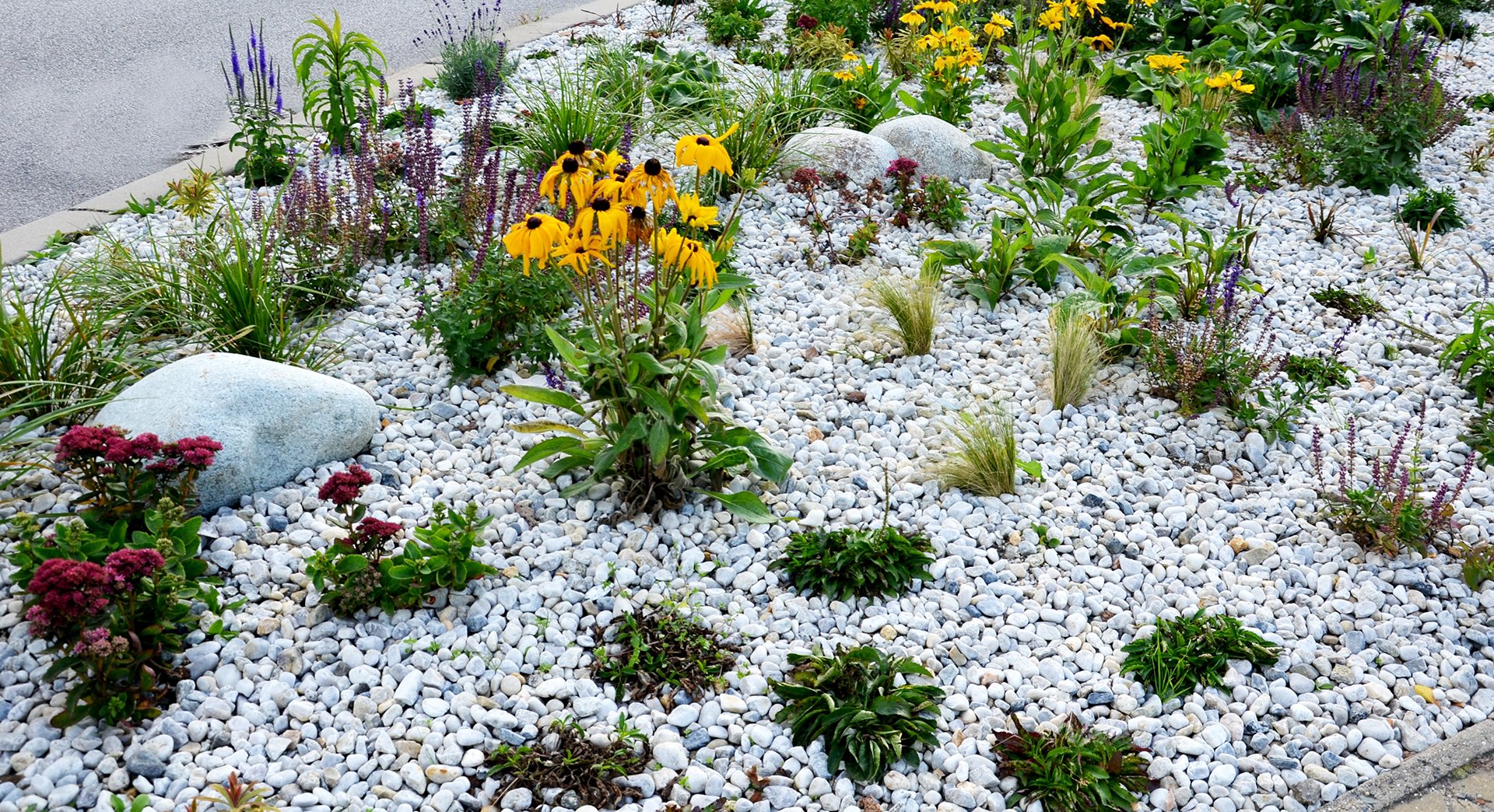
 Ensure proper soil mix, drainage, and air exchange: Plant trees at the right depth, as planting too deep will stress the plants as they struggle for oxygen and cause the tree to push new, weaker roots higher up the trunk. Inspect plant stock upon site arrival and before planting, as nursery digging may have unintentionally placed a root ball too deep within its basket or container. Be sure to implement drainage systems and provide adequate access to air exchange to ensure healthy root growth and soil health. In many cases, it’s not the lack of moisture that puts undue stress on trees, it’s the lack of available oxygen in the soil. By incorporating a system of aeration pipes and vertical ducts into the planting system, better and long-term tree health can be obtained. With the correct balance of engineered soil mix, tree roots can not only survive, but thrive.
Ensure proper soil mix, drainage, and air exchange: Plant trees at the right depth, as planting too deep will stress the plants as they struggle for oxygen and cause the tree to push new, weaker roots higher up the trunk. Inspect plant stock upon site arrival and before planting, as nursery digging may have unintentionally placed a root ball too deep within its basket or container. Be sure to implement drainage systems and provide adequate access to air exchange to ensure healthy root growth and soil health. In many cases, it’s not the lack of moisture that puts undue stress on trees, it’s the lack of available oxygen in the soil. By incorporating a system of aeration pipes and vertical ducts into the planting system, better and long-term tree health can be obtained. With the correct balance of engineered soil mix, tree roots can not only survive, but thrive.
Related Content: La Crosse Downtown Tree Program

Regular monitoring and ongoing care: Implement regular oversight and maintenance programs to identify and address issues promptly. Monitoring can involve measuring tree growth, health, and survival rates, as well as detecting signs of pests, diseases, or environmental stress. Maintenance can involve pruning, watering, fertilizing, mulching, or treating trees as needed. Monitoring and maintenance can be done by professional arborists, city staff, or trained volunteers. Regular monitoring and care can help ensure the longevity and vitality of urban trees and reduce potential risks or liabilities.
Bringing it Together
Urban trees are not just aesthetically pleasing but vital components of sustainable and resilient cities – responsible planning and preservation of trees within urban landscapes should be a top priority. By adhering to best practices, choosing appropriate tree species, and nurturing these natural assets, we can pave the way for greener, healthier, and more beautiful cities, benefiting present and future generations.
Contact us to explore ways to incorporate sustainable tree plantings into your community streetscape.
About the Experts

Karl Weissenborn PLA*, CLARB, ASLA, is an SEH senior landscape architect and project manager who leads complex and sustainable streetscape projects in both public and private sectors. He has extensive experience in leading complex projects from planning to design, with a focus on stakeholder engagement and environmental solutions. He is adept at handling challenging and budget-conscious projects, delivering high-quality outcomes that meet client needs and expectations.
*Registered landscape architect in KS, MN, MI, ND, IA, SD

Jeremy Tomesh, PE* Jeremy is an SEH principal, project manager, senior highway design engineer, and business development leader with extensive transportation and civil engineering experience. He is experienced in identifying the specific needs of a project and working with local officials, state agencies, and stakeholders to find project solutions that address environmental and budget constraints.
*Professional engineer in WI

.png?width=113&name=SEH_Logo_RGB%20(1).png)
